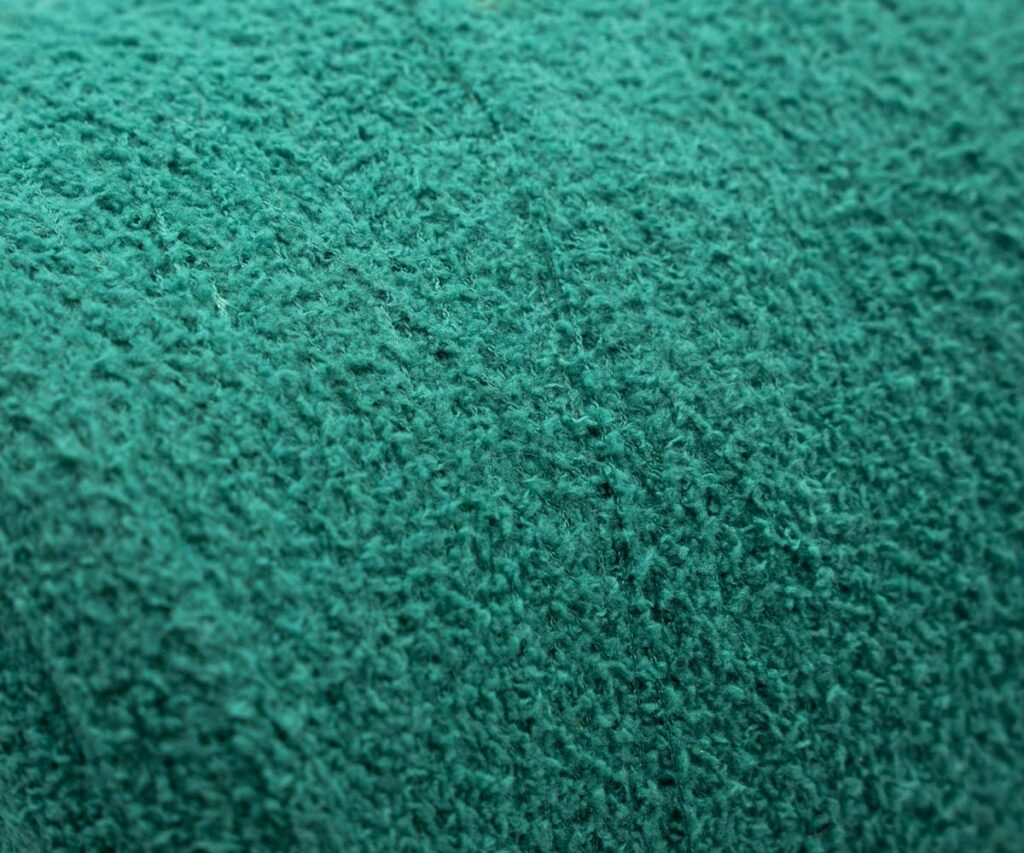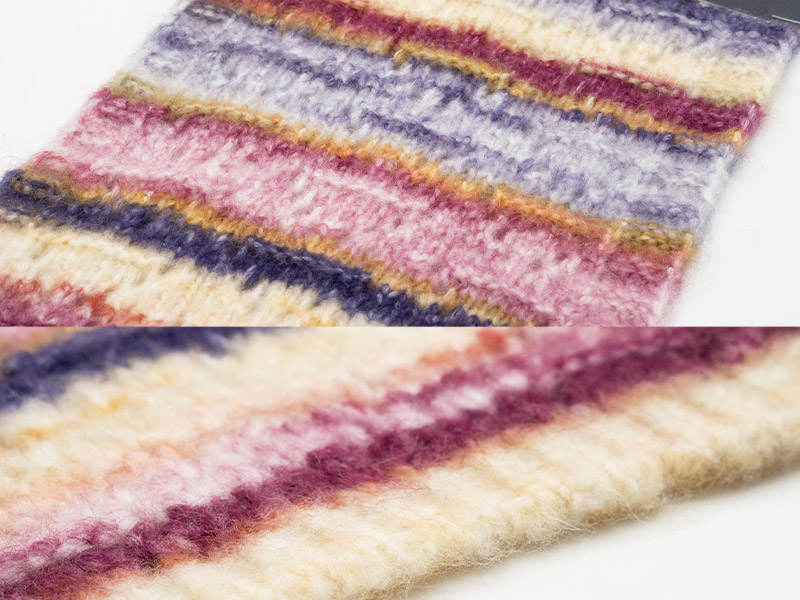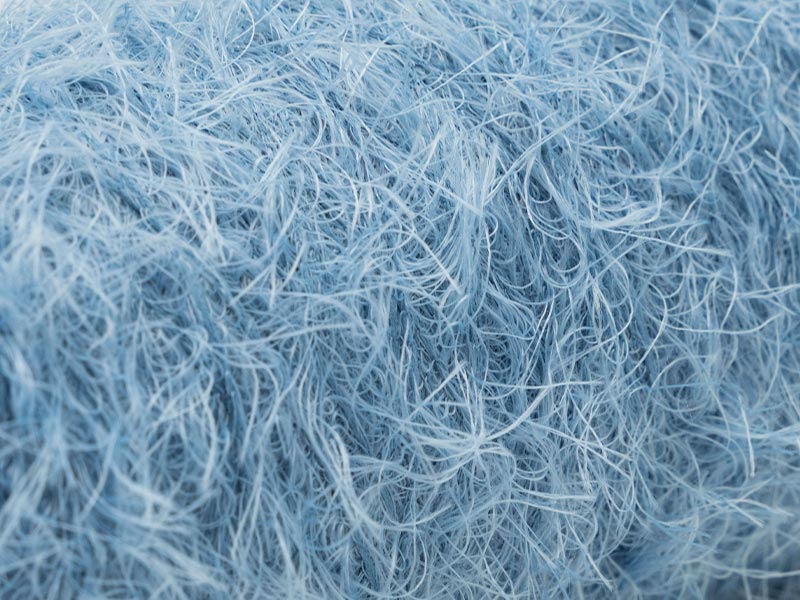Centipede Yarn’s Tactile Revolution: Why a Thousand Fiber Legs Outperform Feathers and Chenille
We spend our lives in a world that is characterized by touch. Stone is solid and comforting, down is soft and giving, and sandpaper is rough and abrasive. Textures help us remember things, make us feel things, and map our reality. This tactile language is very important in textiles. But for decades, the search for “novelty” in fancy yarns generally put the visual shock first. This meant things like the flashy plume, the metallic shine, and the big loop. When people thought about it, texture was typically an afterthought, a side consequence of the visual impression.
But what if the next big thing in textile experience isn’t about making things look louder, but about making things feel better through touch? What if the secret to unlocking deep, complex, and naturally human tactile experiences isn’t perfection, but on purpose, rhythmic imperfection? Centipede Yarn, also called Caterpillar Yarn, is not just a yarn; it is a carefully designed tactile syntax.
We at Duoyou Yarn in Zhangjiagang don’t regard Centipede Yarn as just a new thing; we see it as a change in the way things are done. It shows a shift from surface adornment to profound tactile storytelling, where the yarn itself becomes a conductor of experience, whispering complex stories against the skin. The yarn shows that a real sensory revolution starts with a thousand small, uneven steps.

The Rise of Touch and the Tyranny of the "Perfect" Surface: Beyond Visual Novelty
There have been many beautiful things throughout the history of fancy yarns. Feather yarn is amazing, tape yarn is powerful, and loop yarn is pretty. However, their tactile contribution is typically secondary and can even be an issue, like scratchy metals, stiff tapes, or loops that grab. The look was still the most important thing.
But design and what people want are changing right now. We want things that are real, that connect us, and that use more than one sense. We look for fabrics in our homes that seem “lived-in” and inviting to touch. In fashion, we want clothes that not only look good, but also have a constant, subtle conversation with our skin—warmth, softness, and interesting changes. Performance clothing needs to do more than just work; it also needs to be comfortable close to the skin and feel like it was made that way.
This needs yarns that are made mostly for touch. Yarns that have textures that feel organic and can be adjusted and repeated. Yarns that go beyond the simple “smooth” or “rough” and offer a range of subtle feelings. Centipede Yarn is best at this.
Taking apart the centipede: the anatomy of a tactile wonder
The name “centipede yarn” comes from the way it looks: it has a core yarn with thick tufts or “bushes” of fiber that look like the legs of a centipede or caterpillar. But to get this effect, which seems easy, you need advanced engineering:
1. The Core: The Quiet Conductor (Strength and Rhythm)
• Material: Usually a strong, stable spun yarn (like combed cotton, polyester/cotton blends, or fine wool) or a smooth filament (like polyester or nylon). The core gives the tufts their basic strength and sets the space (pitch) between them.
• Function: The core serves as a metronome in addition to its tensile strength. The tufts show up at exact, regular intervals since the diameter and twist are always the same. The core’s qualities also affect how the yarn hangs and moves in the finished fabric.
• The Duoyou Edge: We carefully choose the core yarns based on how they will be used. Want a knit that is smooth and drapey? A nice cotton core. Do you need upholstery that is as strong as possible? A core made of high-tenacity polyester fiber. We make sure that the rhythmic foundation is excellent by perfectly controlling core twist (TPM/TWI) and count (Ne/Nm).
2. The Effect Fibers: The Tactile Paintbrush (Feel and Look)
• Material: This is where color and texture really come to life. You can use almost any staple fiber, such as soft merino wool for luxury, bright cotton for a natural look, shiny viscose for shine, recycled polyester for durability, or blends for specialized effects. The tuft’s feel and look are greatly affected by the fiber’s denier, length, and crimp.
• Function: These fibers make up the “centipede legs,” which are the thick tufts that stick out from the core in all directions. They provide the yarn with its main tactile identity, which includes its softness, bulk, strength, and visual texture.
• The Duoyou Edge: We know how to choose and prepare fibers well. We know how different fibers act when they are spun in a unique way. We manage the length distribution of the fibers and the pre-opening to make sure that the tufts form consistently and that there is as little fly as possible. We can mix fibers to get unusual textures, like a soft wool core with a little silk for shine in the tuft.
3. The Binding Mechanism: The Invisible Architect (Integrity and Definition)
The Process: The spinning is what makes the magic happen. To keep the core yarn going, specialist machines (typically modified fancy twisters or hollow spindle rigs) are used. The effect fibers are added at random times and securely wrapped around the core at certain spots. This is done with a fine binder yarn (usually a matching or clear filament) or through precision air-jet tangling.
• Function: This wrapping and entangling that happens every so often forms the dense, localized tufts by tightly holding a bundle of effect fibers onto the core at exact intervals. The tight binding keeps the tufts in place during downstream processing (winding, warping, weaving/knitting) and for the rest of the product’s life, so they won’t pull out.
• The Duoyou Edge: This is where precision engineering really shines. We are in charge of:
• Tuft Pitch (Spacing): The space between tufts, such 5mm, 10mm, or 15mm. This rhythm determines how thick the fabric is.
• Tuft Length: How far the fibers stick out from the core (for example, 3mm, 5mm, or 8mm). This has a direct effect on how soft things feel and how visible they are.
• Tuft Density: The number of fibers in each tuft and how tightly they are packed. This has an effect on mass, strength, and opacity.
• Binding Tightness: Making sure the tuft base is securely anchored without losing its suppleness.
The Art of Intermittence: Making Things Exactly Right
Making Centipede Yarn that is always the same quality is like controlled chaos:
1. Core Feed: The core yarn is fed under tension that is controlled by lasers. Any change makes the tuft spacing uneven.
2. Effect Fiber Feed: Staple fibers are fed by a particular system, including a drafting machine with an intermittent feed or a controlled fiber injection nozzle. The size and density of the tufts stay the same when the fiber is delivered at the right time and in the right amount.
3. Binding Application: The binder mechanism turns on as soon as the fiber bundle touches the core.
• Binder Yarn Method: A thin filament or yarn wraps firmly around the core and the fiber bundle several times, holding it in place.
• The Air-Jet Entanglement Method uses high-pressure air jets to tangle the effect fibers with each other and with the core at the binding site. This makes a stable anchor without knots.
4. Rhythmic Control: The whole process—fiber feed, binding activation, and core advance—is done electronically. At every interval, the machine must start and halt the tuft production with amazing accuracy.
5. Winding: The final yarn is coiled into cones with controlled tension to keep the tiny tufts safe and make sure they come off easily later.
Centipede Yarn: A Unique Tactile Territory Beyond Feathers and Loops
Feather Yarn, Loop Yarn (Bouclé), and even Chenille all have texture, but Centipede Yarn has its own unique style:
- Feather Yarn: Makes light, airy plumes. The plumes look great, but they are typically weak, can become tangled up, and don’t allow as much control over the feel of the yarn along its length. Centipede gives you strong, grounded tufts with spacing that you can count on.
- Loop Yarn (Bouclé): This yarn has uneven loops that protrude from a core. Loops can break under strain, seem uneven, and sometimes become stuck. Centipede tufts are thick, stable, and give you a more even, but rhythmically varied, touch experience. The texture is more “pointillist” than “loop.”
Chenille has a soft, smooth surface with a continuous pile. Chenille is soft and luscious, yet it can be hard to shape, crush easily, and have pile difficulties that go in different directions. Centipede has different, discrete points of texture, a base yarn that is stronger and less likely to compress in the tufts themselves, since they are held in place.
The Centipede Advantage: A Call to Action for Tactile Innovation
- Unparalleled Tactile Definition: Provides unique, specific points of texture that make a rhythmic feeling on the skin. You can feel the texture with perfect clarity.
- Controlled Sensory Rhythm: Designers can “score” the tactile experience by using the right pitch. For example, tight tufts give a strong impression, while broader spacing gives a more subtle one. This is a one-of-a-kind level of control.
- Better tuft retention: The strong binding mechanism keeps tufts firmly in place even after a lot of processing (such warping, weaving tension, and knitting) and a lot of use and washing. This is not the case with more delicate fancy yarn textures.
- Different effect fibers (soft wool, crisp cotton, sleek viscose) can change the quality of the tactile sense while keeping the signature structure.
- Visual Texture with Depth: This gives the surface a rich, spotty or nubby look that plays well with light and shadow, offering a layer of sophisticated visual intrigue beyond just flat color.
- Durability Meets Delicacy: The sturdy core can take stress, and the tufts are securely fastened, even though they are very visible. This lets textures that look fragile work well.
- Application Versatility: It opens openings in many different markets:
- High-end knitwear: sweaters, cardigans, scarves, and hats with beautiful, long-lasting texture elements like cuffs, collars, and all-over designs. Picture a merino centipede yarn making soft, velvety nubs all over a fine-gauge garment.
- High-End Upholstery & Drapery: Adds elegant, appealing textures to drapes and furnishings. Cotton or wool Centipede yarn gives depth and a tactile appeal that makes you want to touch it. It’s great for both homes and businesses.
- Statement Accessories: Bags, belts, and shoes with unusual, eye-catching, and long-lasting textures.
- Creative Fashion Fabrics: Used as weft in woven fabrics to make stripes, checks, or effects that cover the whole thing. Great for coats, skirts, and other one-of-a-kind clothes.
- Baby and children’s clothes: Soft acrylic or cotton centipede yarn gives things made for young hands to explore a fun, interesting texture that lasts a long time when washed.
- Technical Textiles: Depending on the tuft density and fiber choice, these fabrics may be able to act as spacers or provide particular insulating properties.
Duoyou Yarn: Making Your Tactile Symphony
We don’t simply make Centipede Yarn at Duoyou Yarn; we also design unique tactile sensations. Our Zhangjiagang facility is a place where we test new ideas for textures:
1. The Sensory Brief: We work together a lot. What kind of feeling do you want? (Soft comfort, I’m clear definition?) What is the use? (Knitwear cuff, upholstery panel, woven accent?) What kind of performance do you need? (Abrasion resistance, wash cycles, and drape?)
2. Material Orchestration: Our techs choose based on your brief:
- Core: The best material, count, and twist for strength, drape, and pitch stability.
- Effect Fibers: The type(s) of fiber, the blend ratios, and how they are prepared to get the right tuft softness, bulk, durability, and color.
- Binding Method: Use binder yarn (material, denier) or air-jet settings to get the best anchoring and feel.
3. Precision Parameterization: We program our machines with very precise details:
- Tuft Pitch (mm): Setting the beat.
- Tuft Length (mm): Setting the prominence.
- Tuft Density (fibers per tuft): This tells you how filled the tuft is.
- Binding Force: What makes it safe
4. Constant Quality Control: Every batch is checked for things like consistent tuft spacing, tuft pull-out force, tensile strength, and visual examination for flaws. Rhythm must always be the same.
5. Sustainable Textures: We have recycled polyester/nylon cores, GRS-certified recycled cotton/wool/viscose for effect fibers, and bio-based alternatives. This way, your tactile inventions will be in line with your environmental beliefs.
The Future is Textured: Hear the Centipede's Whisper
The story of fancy yarns is changing from just being seen. The future is for yarns that tell stories not only to the sight but also to the hand and skin. Centipede Yarn is a great example of how to be intentional with your touch. It’s a yarn that knows that texture isn’t a single thing, but a language made up of rhythm, density, and fiber whispers.
The yarn allows you make a couch that calls to you with its nubby comfort. The yarn turns a plain sweater cuff into a lovely environment to explore. The yarn shows that new ideas can be felt as much as they can be seen.
Stop making things that only look good. Begin writing for the hand.
Work with Duoyou Yarn. Let us design the Centipede Yarn that will bring your next tactile work of art to life.
Are you ready to feel the rhythm of touch? For a consultation and access to our Centipede Yarn technical documentation and sample collection, get in touch with Duoyou Yarn today.
Related News
Discover more about the latest developments in the yarn industry, explore articles on development trends and innovative technologies, and provide you with more industry insights.

Wool Acrylic Blend Yarn: Benefits, Uses & Wholesale Sourcing Guide
The choice of fiber in the textile industry affects not only the quality of the finished product, but also how well it works, how much it costs, and how much people want to buy it. Wool and acrylic are two of the most popular fibers, and each has its own benefits. Wool is known for being warm, strong, and breathable, while acrylic is known for being strong, cheap, and easy to care for.

Redefining Fall/Winter Knitwear with Four Unique Yarns
Sweaters are no longer just about “keeping warm” — they’ve become a statement of autumn and winter style.
In the past, the primary function of sweaters was to provide warmth, durability, and practicality, especially in colder regions where they were essential for winter protection. However, today’s consumer trends have quietly shifted — while functionality remains important, design and style expression have become equally indispensable.

Fancy yarns, often referred to as novelty yarns, are yarns that deviate from traditional yarn types by featuring unusual textures, colors, and patterns. These yarns are designed to add decorative, creative, or artistic elements to fabric, enhancing the visual appeal and texture of any textile project. Fancy yarns can be used for a variety of purposes, including fashion garments, home décor items, and craft projects. The defining feature of fancy yarn is its ability to create unique, eye-catching designs due to its distinct appearance and texture.

